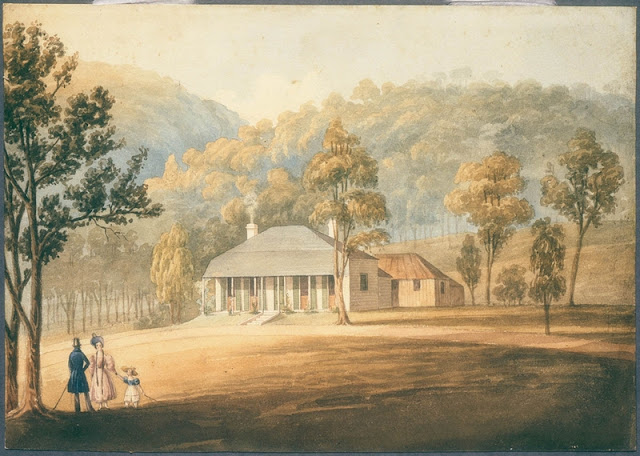Samuel Taylor and the 1841 Census
 |
| A Settler's Home, New South Wales, ca. 1841 / watercolour by Frederick Garling. The image is from the collections of the State Library of NSW. |
According to Nick Vine Hall's Tracing Your Family History in Australia: a Guide to Sources:
"The first full census of new South Wales was not made until 1828. Subsequent censuses were taken sporadically in the various colonies until 3 April 1881, when a census was taken for the first time on the same date throughout Australia."
I decided to look at the 1841 Census for my 3 x great-grandfather, Samuel Taylor.
The 1841 Census was taken on 2 March and is indexed and held on microfilm by the State Records of NSW (referred to as AONSW in Vine Hall's book) and the National Library of Australia (NLA). You can search the index on State Records site here or you can look at the digitized version on Ancestry.
I am lucky that Samuel lived on the Murrumbidgee as not all places have names of individuals listed e.g. Lachlan and Liverpool districts.
I can view an entry on an index to Abstracts: Berrima to Sydney here which gives the following information:
TAYLOR, Samuel
Return No. 46
Residence: Tharmus, District Murrumbidgee
No. of persons: 6
Location: X947, p. 89
Another Index entry here shows slightly different information.
TAYLOR, Samuel
Return No. 22
Residence: Murrumbidgee
No. of persons: 7
Location: X951, p. 131
Reel 2223
The conflicting index information really makes me want to look at the microfilms at the Records Office of NSW!
I can view Form C or the Abstract of Samuel Taylor's record here. It is on Page 5 of the Murrumbidgee Abstract - entry number 45.
The name of the establishment (as per the column header) is shown as Tharmus. I believe this is an interpretation of the name of the property called Taemas. Samuel must have had a thick Kentish accent!
At the time there were two males living there aged between 21 and 45 and four females (one aged between 2 and 7, one aged between 7 and 14, one aged between 14 and 21 and one aged between 21 and 45 years of age).
One male and three of the females were born in the colony. One of the males was described as a stockman and one female as a domestic servant. I am going to estimate that the makeup of the household was as follows:
Samuel Taylor would have been aged about 44.
Samuel's son, Samuel, was born in 1833 so would have been aged about 8 so I think the other male was a stockman.
Margaret Taylor (nee Jones) - Samuel's wife would have been aged about 32.
Margaret their daughter who was born in 1837, would have been about 4 years old.
I am guessing that the other two females were a domestic servant and perhaps another child of Margaret's that I didn't know ....or a child of the domestic servant.
Their religion was Church of England.
The house was made of wood, finished and inhabited.
Whilst the picture at the beginning of this post is charming, I suspect my ancestor's home may have looked more like this.
There would have been no sewerage or running water in the home. Water would have been carried in to the house in buckets I imagine. There would have been no electricity. Winter would have been "bitter cold" as my grandmother used to say. And central heating could not have been imagined. I can understand why Samuel would have taken a wee dram to keep himself warm.
Page 8 of the Abstract gives the totals for the area called the Murrumbidgee. They are as follows:
Males - 1258 (782 free and 476 bond)
Females - 281 (272 free and 9 bond )
Hmmm....there's something to think about there for a start.
Of the 167 dwellings, all were wood and only 7 were unfinished.
The majority of people were employed looking after sheep or in agriculture. The next highest occupational group was domestic servants.
867 people identified as Church of England and 482 as Roman Catholic. The next highest group was Church of Scotland. Three people were identified as Mahomedans or Pagan and 4 as Jews.
At the bottom of the abstract is a signature which I read as Henry Bingham. He would have checked the returns and sent the abstract to the Colonial Secretary. For a more detailed description of how the census was enacted and collected read here.
There are some fascinating articles to be found on Trove about Henry Bingham. I attach some here which will give you an idea of what it was like working as the Commissioner in the area at the time.
 |
| 1840 'MURRUMBIDGEE.', The Sydney Herald (NSW : 1831 - 1842), 28 November, p. 2. , viewed 07 Aug 2016, http://nla.gov.au/nla.news-article12866754 |
and
 |
| 1844 'ABORIGINES.', The Colonial Observer (Sydney, NSW : 1841 -1844), 28 November, p. 6. , viewed 07 Aug 2016, http://nla.gov.au/nla.news-article226466821 |
Much food for thought here, methinks.





Comments
I may just have to look for some of mine after all. Thanks, Alex.
It is a good thing that we all enjoy researching and endless questions. :)
As always, I have enjoyed reading your post. Have a blessed day (or night, whichever is the case).